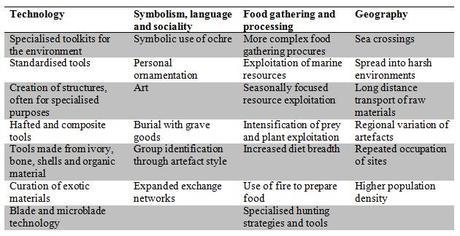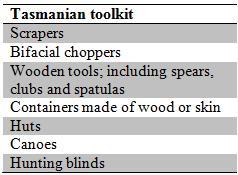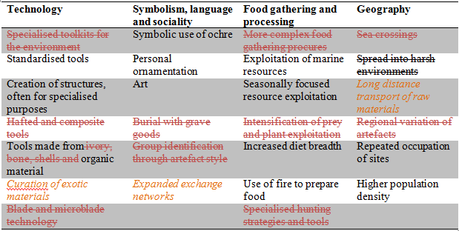Humans are the last surviving members of our family, the hominins. Scientists have been trying to explain this fact for as long as its been known. One of the more popular explanations is that we were simply smarter than all our relatives, but how to prove this? Brains, after all, do not fossilise. Enter “behavioural modernity” (BM). Behavioural modernity is a suite of behaviours, tools and strategies thought to correlate with “cognitive modernity” (aka modern human levels of intelligence); or are the products of cognitive modernity that allowed humans to flourish1. And the lovely table below details these behaviours.

I made this table for you, I hope you like it
Now those of you with an exquisite memory might be able to remember a grand two days into the past; when I discussed research that showed Neanderthals also had many of these behaviourally modern behaviours (but not all of them). Surely, then, Neanderthals were just as smart as modern humans! If they had behavioural modernity then they must also have had cognitive modernity2! Or maybe, just maybe, behavioural modernity is not a great indicator of cognitive modernity after all.
To test this is quite simple. All groups of modern humans are cognitively modern, so they should all possess the traits listed in my fancy table; regardless of how simple or complex their technology is. So lets examine the indigenous Tasmanians. Those of you with an even better memory than those table-spotters will recall this is a peculiar group of people who appeared to have “forgotten” a large chunk of their technology a few thousand years ago (those of you without a great memory can click here to learn more about it). Although the amount they forgot and why is hotly debated, the fact is that as a result of whatever happened, they had one of the simplest toolkits in the world. But if the idea behind behavioural modernity is right, they should still have all of the stuff in the table.
Unfortunately the indigenous Tasmanians were wiped out by Europeans more than a hundred years ago. Fortunately for us though (I guess), those who were doing the wiping out kept very detailed records of the culture they were destroying4. How nice of them. This, combined with archaeological excavations on the island, means we have a pretty thorough understanding of these people. So do they meet the criteria for behavioural modernity?
Short answer: no.
Long answer: could go on for 5,000 words. So here’s a medium-length answer instead

The Tasmanian toolkit. From 3
- Technology: Here’s another awesome table I made, this time of the Tasmanian toolkit. As you can see they’re missing a lot of BM characteristics, including hafted tools, bone tools, blades or specialised tools. However, they did have standardised tool types and wooden tools3. They also transported raw materials from over 100km away4; which is at the lower end of what prehistoric modern humans were doing, so whether that matches the criteria is debatable6.
- Geography: There’s no evidence of them crossing seas (even though they had canoes) and there’s little regional variation in their technology, so that’s more BM not seen here. They did have population densities similar to other modern humans though, so that’s a point in their favour3. However, there aren’t any really harsh environments on Tasmania, so that’s something we can’t test one way or the other.
- Food: For food they meet a lot more “modern” standards. They had a broad diet including shellfish. They cooked their food with fire and migrated around the island to maximise their hunting in each season. However, their toolkit wasn’t specialised (as mentioned) and they didn’t intensively exploit any of their resources3.
- Symbolism: This is where they meet the most modern standards. They used ochre, made art, had beads and language. The exception being the fact they did not bury their dead with grave goods and5, as I said, there’s no evidence of any regional styles in their technology3.
So when we look at what defines behavioural modernity, we have to drop a lot from the definition. Most of the technological characteristics are thrown out the window, as is a lot of the food related stuff and geography and….you know what; I’ll just put it another lovely table for you nice people.

The behaviourally modern traits identified in table 1 which were present in Tasmanian aboriginals. Red strike-through indicates absence, black strike-through indicates untested, orange italicised indicates possible presence, normal font indicates definite presence.
Now I’ve been complementing the memory of some readers for most of this article; but if you’ve spotted the conclusion here I will be very impressed. Because those of you whose memory is the best of the best might have noticed that the bits of behavioural modernity we have to drop from the definition are the handful of “modern” things Neanderthals didn’t have. Things like blades and sea crossings.
Which has some rather interesting implications: either this whole behavioural modernity is a wrong idea we need to do away with (which is something I’m inclined to agree with, given how thoroughly its been gutted by this investigation) or Neanderthals are just as smart as modern humans. Regardless of the right answer, it’s kind of a big deal either way. Either we’ve got to do away with this notion of behavioural modernity and go back to square one when figuring out what makes humans so special, or Neanderthals were just as smart as us after all.
I think the significance of that last one needs no explanation. Not only would that set us back to square one when trying to understand why humans became so successful, but it would grant our most special, unique characteristic – intelligence – to another species. Our only claim to fame, shared with a short, squat, barrel chested, hairy caveman.
References
- McBrearty, S. and Brooks, A. (2000). The revolution that wasn’t: a new interpretation of the origin of modern human behavior. Journal of human evolution, 39(5), pp.453–563.
- Villa, P., & Roebroeks, W. (2014). Neandertal Demise: An Archaeological Analysis of the Modern Human Superiority Complex. PloS one, 9(4), e96424.
- Jones, R. (1977). The Tasmanian paradox. In: Stone tools as cultural markers: change, evolution and complexity, 1st ed. Canberra: Humanities Press, pp.189 – 204.
- McGrew, W. (1987). Tools to get food: the subsistants of Tasmanian aborigines and Tanzanian chimpanzees compared. Journal of Anthropological Research, pp.247–258
- Lord, C. E. (1923). A note on the burial customs of the Tasmanian Aborigines. In Papers & Proceedings of the Royal Society of Tasmania (pp. 45-46).
- Féblot-Augustins, J. (1993). Mobility strategies in the late Middle Palaeolithic of central Europe and western Europe: elements of stability and variability. Journal of Anthropological Archaeology, 12(3), 211-265.

